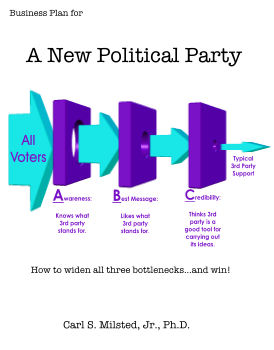Part 1 Summary
Third party politics is very difficult in the United States but it is not impossible. If you have read the chapters leading up to this one you should now understand the three iron rules for third party success in the United States (and any other country with first-past-the post district elections). It’s time to review and lock in this core knowledge before getting into the nitty gritty details .
Rule 1: A successful third party must be moderate enough to win somewhere.
Rule 2: A third party needs some principles.
Rule 3: A third party must have a base of voters/activists that is indifferent to the difference between the Democrats and Republicans.
(If you came to this page via the search engines, start here to understand what I’m talking about.)
It is difficult to follow all three rules at the same time. For a left or right wing party, following Rule 1 violates Rule 3. Most centrist parties violate Rule 2. Today’s minor parties follow no more than two of these laws at the same time, and thus remain minor. Following all three rules at the same time is challenging enough that many consider successful third party politics to be impossible, and third parties a waste of time. I disagree. I have found two loopholes in Duverger’s Law:
- Triangulate. If we view the political playing field in more than 1 dimension, we can find regions ill served by either major party yet still close enough to the center to have a large constituency. The libertarian region on the Nolan Chart is one such region, so the Libertarian Party could grow much larger should it drop its extremism. But much better opportunities lie for a party based on the ideas elsewhere on this site.
- Focus on two-way races. Many state legislative races go uncontested. A third party could thus be a second party in those races, bypassing Duverger’s Law entirely.
Strategy vs. Tactics
It’s time for a quick chess analogy. Teach someone just the rules of chess and that person is unlikely to learn the core strategies of chess even after playing similarly trained players for years. Such a player will get better over time at seeing combinations, laying traps, etc. but I can in an hour or less train a greener chess player to crush him by teaching the mere basics of chess opening theory:
- Controlling the center is your primary goal in the opening.
- Get as many pieces in play as possible early on.
- (Corollary) Try to avoid moving a piece twice during the opening.
And untrained chess player can gain the equivalent of years of uncoached experience in about an hour by just internalizing these simple rules. I have just given you the equivalent rules for launching a successful new political party.
To continue the chess analogy, mastery of the above rules of thumb can allow one to crush green players. It won’t make you a chess master, or even a moderate competitive player. The rules of thumb above are necessary but not sufficient.
The same holds for my rules for successful third party politics. To actually succeed still requires mastering the nitty gritty details of campaigning, election law compliance, party building etc. You can acquire some of this experience by recruiting experienced volunteers from the major parties or hiring consultants.
But there are dangers in doing so! Third party politics is different from major party politics. The fundraising tactics of a typical Demopublican campaign will not work for a third party campaign. You will burn up the funds you raise on fundraising expenses. There are differences in advertising, volunteer recruiting, party governance and more. Fortunately for you, I wrote a manual.
Read on!


